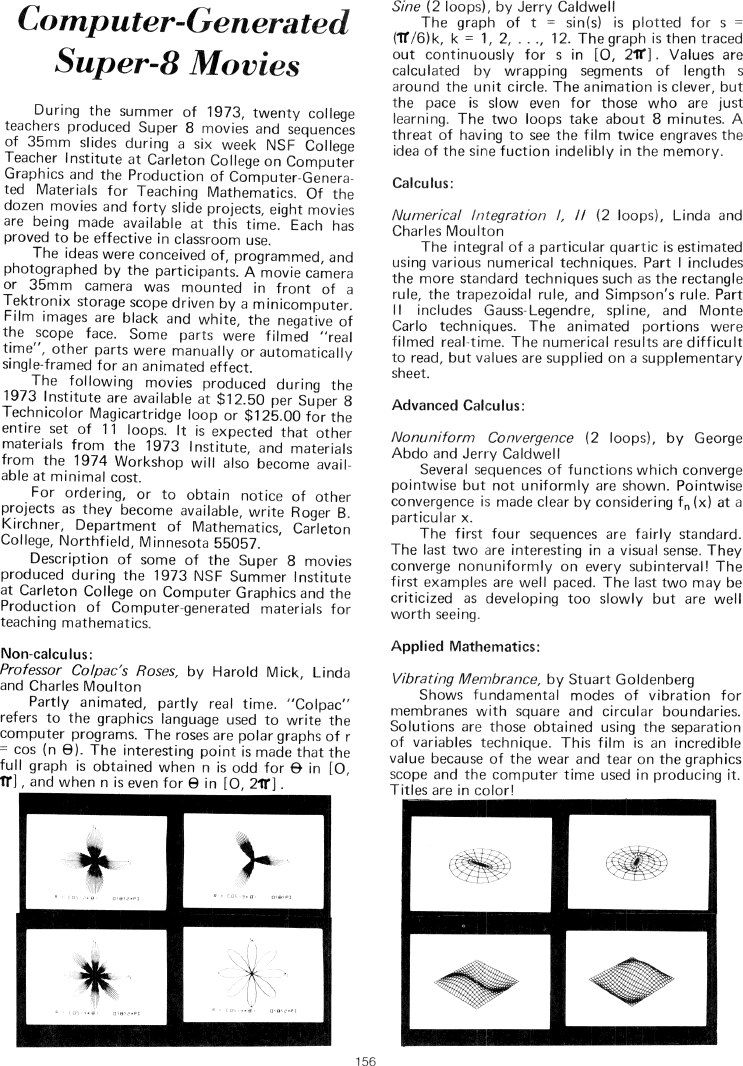The Best of Creative Computing Volume 1 (published 1976)
Computer-Generated Super-8 Movies (1973 movies)

Computer-Generated Super-8 Movies
***
During the summer of 1973, twenty college teachers produced Super 8 movies and
sequences of 35mm slides during a six week NSF College Teacher Institute at
Carleton College on Computer Graphics and the Production of Computer-Generated
Materials for Teaching Mathematics. Of the dozen movies and forty slide
projects, eight movies are being made available at this time. Each has proved to
be effective in classroom use.
***
The ideas were conceived of, programmed, and photographed by the participants. A
movie camera or 35mm camera was mounted in front of a Tektronix storage scope
driven by a minicomputer. Film images are black and white, the negative of the
scope face. Some parts were filmed "real time", other parts were manually or
automatically single-framed for an animated effect.
***
The following movies produced during the 1973 Institute are available at $12.50
per Super 8 Technicolor Magicartridge loop or $125.00 for the entire set of 11
loops. It is expected that other materials from the 1973 Institute, and
materials from the 1974 Workshop will also become available at minimal cost.
***
For ordering, or to obtain notice of other projects as they become available,
write Roger B. Kirchner, Department of Mathematics, Carleton College,
Northfield, Minnesota 55057.
***
Description of some of the Super 8 movies produced during the 1973 NSF Summer
Institute at Carleton College on Computer Graphics and the Production of
Computer-generated materials for teaching mathematics.
***
Non-calculus:
***
Professor Colpac's Roses, by Harold Mick, Linda and Charles Moulton
***
Partly animated, partly real time. "Colpac" refers to the graphics language used
to write the computer programs. The roses are polar graphs of r= cos (n Ѳ). The
interesting point is made that the full graph is obtained when n is odd for Ѳ
in [O, π], and when n is even for Ѳ in [O, 2π].
***
[Image]
***
Since (2 loops), by Jerry Caldwell
***
The graph of t = sin(s) is plotted for s = (π/6)k, k = 1, 2 , ..., 12. The
graph is then traced out continuously for s in [O, 2 π]. Values are calculated
by wrapping segments of length s around the unit circle. The animation is
clever, but the pace is slow even for those who are just learning. The two loops
take about 8 minutes. A threat of having to see the film twice engraves the idea
of the sine fuction indelibly in the memory.
***
Calculus:
***
Numerical Integration I, I I (2 loops), Linda and Charles Moulton
***
The integral of a particular quartic is estimated using various numerical
techniques. Part I includes the more standard techniques such as the rectangle
rule, the trapezoidal rule, and Simpson's rule. Part Il includes Gauss-Legendre,
spline, and Monte Carlo techniques. The animated portions were filmed real-time.
The numerical results are difficult to read, but values are supplied on a
supplementary sheet.
***
Advanced Calculus:
***
Nonuniform Convergence (2 loops), by George Abdo and Jerry Caldwell
***
Several sequences of functions which converge pointwise but not uniformly are
shown. Pointwise convergence is made clear by considering fn (x) at a particular
x.
***
The first four sequences are fairly standard. The last two are interesting in a
visual sense. They converge nonuniformly on every subinterval! The first
examples are well paced. The last two may be criticized as developing too slowly
but are well worth seeing.
***
Applied Mathematics:
***
Vibrating Membrance, by Stuart Goldenberg
***
Shows fundamental modes of vibration for membranes with square and circular
boundaries. Solutions are those obtained using the separation of variables
technique. This film is an incredible value because of the wear and tear on the
graphics scope and the computer time used in producing it. Titles are in color!
***
[Image]
***
156


